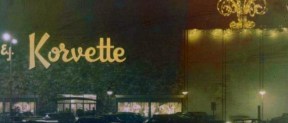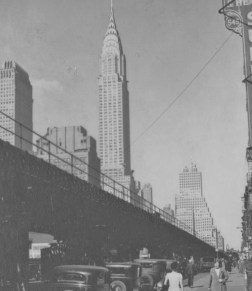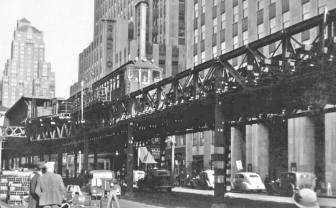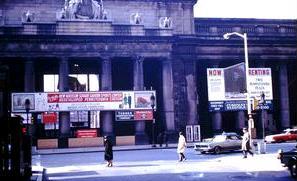In the realm of New York history, there are some urban myths so etched onto our consciousness that no matter how many times the facts are laid out, the myths keep coming back. In other cases the very thing we think is myth can actually turn out to be the truth.

Douglaston Store via http://servicesignny.com/
Take EJ Korvettes’s Department Store, the place we all went to get records in the 60’s and 70’s. It is said that the name came from the eight Korean War Veterans who founded the store. But the reality is that only one person founded the store, Eugene Ferkauf, and the name was conceived as a combination of his and executive Joe Swillenberg’s first initials, followed by what Eugene described as a deliberate misspelling of the Corvette type navy vessels (and not the sports car). The Korean War didn’t begin until two years after the EJ Korvette’s name had already been established. However Ferkauf and Swillenberg were both World War II veterans, and they were both Jewish, so perhaps the name of the store could have been TJ WWarvettes.
Another urban myth that lingers when it comes to New York City history is that the steel from certain elevated train lines was torn down and sold as scrap metal and eventually wound up in the hands of the Japanese in World War II as weapons, that it made its way back to the states in the form of Japanese bullets. There is nothing funny about the thought that the very people who rode trains in the city were killed by parts of the very structures that had lain under them.
At first this accusation seemed preposterous to me, but upon further examination, it’s not as crazy as it sounds. The timing is right, the Sixth Avenue El was dismantled in the late 1930’s, and the US did sell tons of steel to Japan at that time. The remains of the subway was in fact sold as scrap metal, so some of that metal easily could have made its way over to Japan through one sale or another.
Wikipedia quotes a statement on its Sixth Avenue El page by an attorney for the Harris Structural Steel Company, involved in the demolition, telling syndicated columnist George Sokolsky that reports of the sale of steel from the El to Japan were not accurate. But how does he know?
Maybe the scrap metal wasn’t sold directly to Japan, but how can the company possibly account for every trace of of steel it sold and where all that steel went? It may make us feel better to think that 6th Avenue el steel was never used on us as artillery, but the truth is that we will probably never know, and there certainly is the possibility that it was.
The demolition of the El’s is a sensitive topic for Manhattanites, even without the potential added insult that it was used against us in a war. The residents on the east side of Manhattan, who once had both Second and Third Avenue Els to use for transport, have been waiting for their replacement for more than 50 years. Only now is the Second Avenue subway slowly and painstakingly making its way downward through northern Manhattan. The lack of funding for a new subway system for many of those years is due to the fact that Robert Moses appropriated so much of the city funds that could have gone to it for his road projects.
As far as Moses, the man who tried to build New York in his own vision, we seem to have our own set of urban myths, some are true and some are not. I usually try to present Moses on my Facebook page one aspect of his career at a time. hoping to invite further discussion on each one. However most people choose to just give their overall opinion about the man, good or bad. Many repeat the same accusations, or defend him in the same way, but a lot of the facts given are not accurate.
Moses did not have anything to do with the destruction of Penn Station. It was owned by a company which the city had no control over. Even if Moses had wanted to destroy it, there was little he could have done about it. At the time of the Penn destruction, Moses was busy elsewhere anyway, preparing Flushing Meadows-Corona Park for the 1964 World’s Fair. He was President of the fair, a job which most people don’t seem to know he held.
Moses never made his parkways intentionally winding, or wanted them built with short exit and entrance ramps, as some accuse him of doing. Even the most outspoken critics agree that his roads were engineering marvels for their time. Also, Moses did not want to build the Northern State Parkway around Westbury, although many accuse him of being complicit in constructing the detour. He hated the wealthy landowners there and would have loved nothing more than to ram his parkway right through the driveways of their precious mansions. But the wealthy residents were able to dig up enough potentially embarrassing dirt on Moses to leave him almost no choice but to have to weave his road two miles to the south and around their Old Westbury estates.
Finally, there are many who defend Moses more or less solely on the basis that his roads and bridges are just too great as mere accomplishments. They say that to consider him anything less than a great man, no matter what else he may have done, is inappropriate. I think these people are perpetrating an urban myth of their own, or at least being ignorant in their complete analysis of Moses. If you are going to defend Moses, you need to come up with a more convincing argument. The pyramids of Egypt are great masterpieces, too, it doesn’t mean the pharos who built them weren’t ruthless dictatorial tyrants either.




aspicco
/ June 16, 2013My only complaint about Robert Moses is how he dissed public transportation. and how he preferred bridges to tunnels. We could have a subway line that connects to Staten Island from Brooklyn if we had a Verrazano Narrows Tunnel instead of a bridge… and we could have had a rail line in the middle of the Van Wyck that connected to JFK airport… but nope. Ah well… onwards and upwards
joe gibbons
/ March 22, 2015i agree, but when was it decided that nothing else be built? we should have monorails like the JFK sky train connecting to LAG and NYC and more tunnels.the jfk rail is up and running, but why stop only at jamaica?
Todd Berkun
/ March 22, 2015Couldn’t agree more.
Kathleen Motley-Hale
/ June 17, 2013I remember my late mother telling a story about how she and her father ( who died in 1941) would sit and watch the barges filled with metal leave New York for Japan. She said her father said “Matey, they’re going to throw all of that metal back at us one day.”. Interesting to see a bigger story.
Tom Orzo
/ June 17, 2013Robert Moses has to be considered a “great man” insofar as his impact on NYC is probably indelible – who among us can say that? I appreciate that this blog is striving for a nuanced appreciation. There can be no question of RM’s two sides: “Moses the Good, and Moses the Bad.” He knew the City as well as anyone, and he knew how it worked, and he GOT THINGS DONE – for better and for worse. In this, I compare him to Michael Bloomberg. Incredibly smart and accomplished men, yet somehow detached from the people they serve/govern/rule! They are essentially technocrats, very competent with the levers of power, but I never got the impression that either one of them likes people. The impact of Moses is no doubt the greater, because of his duration – far, far longer than any politician. Nobody put it better than Biographer Robert Caro: Robert Moses was “The Power Broker.”
manhattan resident
/ June 17, 2013I am by far not a fan of Moses, but when he built those roads, the federal government was giving money to build those now awful, potholed roads. No mass transit needed as gas was about 15 cents a gallon. The government plan was to build a cross country interstate highway system. And they did build that system. Too bad gas is now almost 4.00 a gallon.
Peter Bono
/ November 15, 2023It wasn’t a myth that he purposely built the overpasses on the parkways low to keep out buses (and us city kids) from his beloved beaches!
Todd Berkun
/ November 15, 2023What are you basing that on that it wasn’t a myth. Robert Caro based his ‘proof’ on it by an explanation he was given by Syd Shapiro Moses chief engineer. Is that conclusive proof? Probably not. So you can say you believe it was not a myth and you might be right. But for those who want to refute it, they also have ground to stand on as well. The Washington Post wrote about it and came up with an inconclusive evidence answer as their conclustion. If I can find the link I will add it.
Peter Bono
/ November 15, 2023He did accomplish a lot but I think you give Robert Moses’ underhanded and perhaps even prejudicial practices too little notice.
Peter Bono
/ November 15, 2023Basic reasoning suggests it wouldn’t have taken much to built those overpasses a few feet higher….
Todd Berkun
/ November 15, 2023OK let’s say you are even correct and the bridges were too low – (and I am only giving you that for the sake of argument the proof is not completely overwhelming, is it truly racist? For the sake of discussion and moving things along lets say it was intentional?
Then I have a question … Are all the people in the buses who the low bridges built to keep out black? And are all the people in the cars who could still get there white?
See you have to assume thats the case for it to truly be racist – that every white person is in a car, and every person in the bus is black. To truly be a racist act. And of course thats not true – the busses would have white people and some blacks would have cars. So …
Even if it true the bridges being low is really classist at best not racist. In that people who couldn’t afford cars would not be able to get to the beach.
Its easy to say a guy is racist and I don’t doubt that he may have been – but using the bridge thing as proof is a weak case to make. I’m not defending Moses per say, but you can’t just say he was racist because of basic reasoning that’s the case and have it convince anyone.